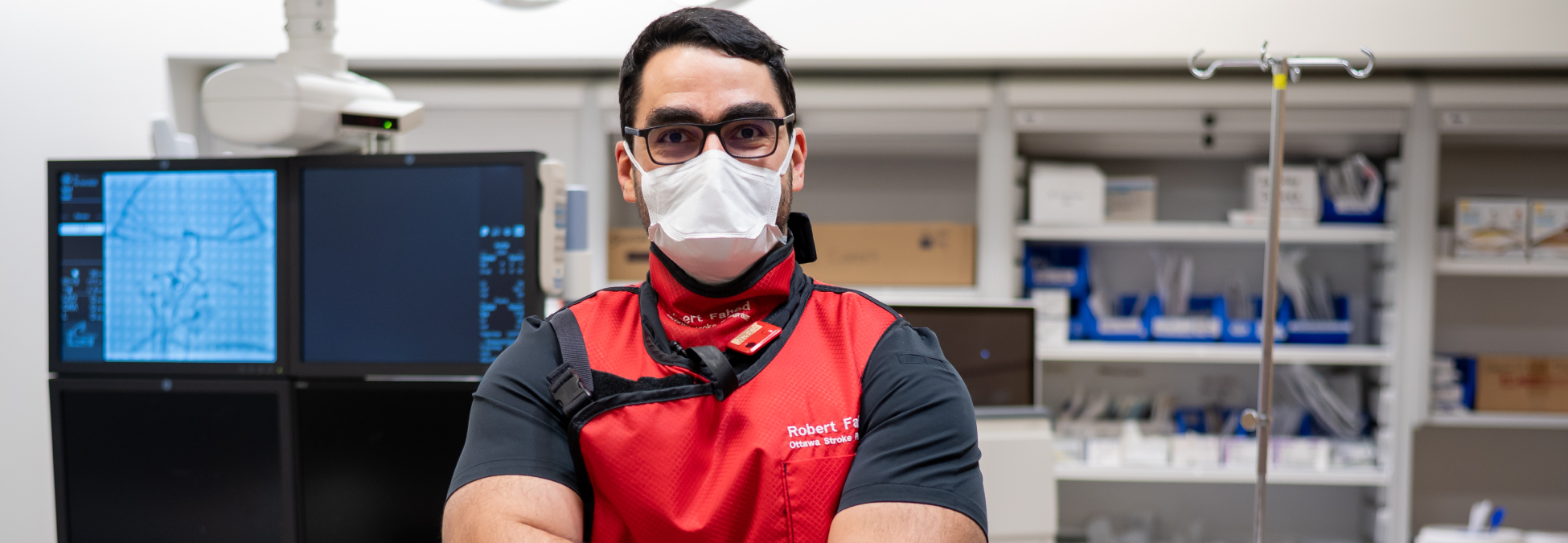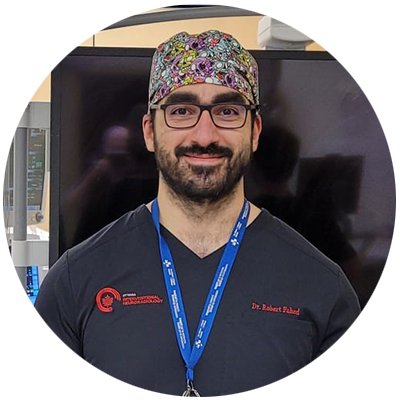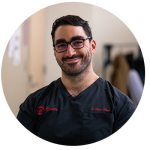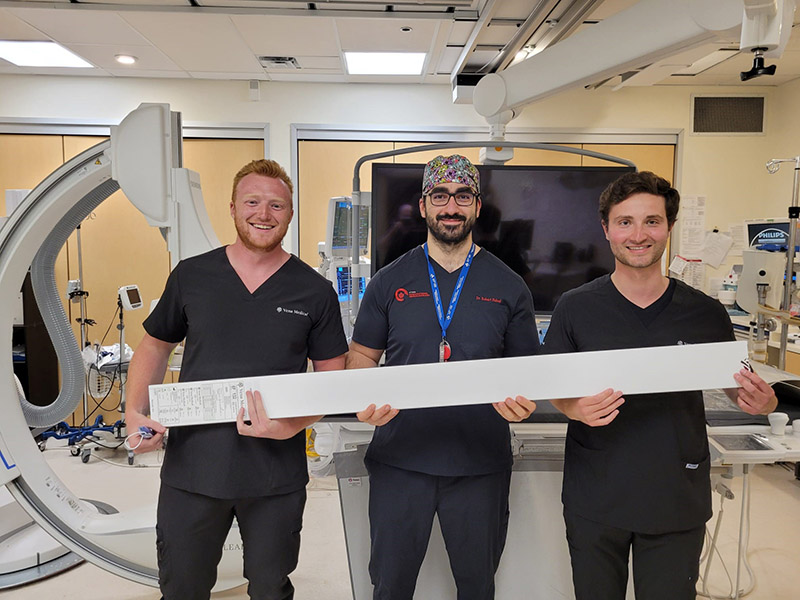
Life-altering stroke treatment and care from a “gym rat”
Meet The Ottawa Hospital’s Dr. Robert Fahed, one of only four interventional neurologists in Canada

Not all heroes wear capes — Dr. Robert Fahed plucks blood clots from the brains of stroke patients, saving lives and mitigating injury. The revolutionary process, called thrombectomy, is just a part of what Dr. Fahed brings to the fight against strokes and their disabling effects as an Interventional Neuroradiologist and Stroke Neurologist at The Ottawa Hospital, and Assistant Professor at the University of Ottawa. After training in France, Dr. Fahed was recruited by The Ottawa Hospital, and he’s become known for his practice-changing research and care for stroke patients — and others.
Read on to learn about the eyebrow-raising moment Dr. Fahed learned about thrombectomies and why he chooses to call Ottawa home.
Q: How did you wind up at The Ottawa Hospital?
A: I was born and raised in the suburbs of Paris, France. Both my parents immigrated from Syria before I was born because they wanted a better life for their kids. I’ve always felt like everything I’ve achieved was thanks to them.
I did my neurology residency in Paris, and then I did my master’s degree in Montreal, because I wanted to do research. I have family in Montreal, and I’ve always loved Canada, ever since I was a kid. Why Ottawa? It’s for three reasons: two personal, one professional.
Number one is that The Ottawa Hospital is known for its great research infrastructure and how they support researchers. Number two is that Ottawa is a peaceful, quiet, family-friendly city, and I wanted exactly that environment to raise my kids. Number three is I find it very stimulating to be constantly working in and speaking English. It stimulates my brain because it’s not my natural language. My brain is always functioning at a higher pace because of it, and I like that.
Q: Why did you choose to go into neurology?
A: My father is a neurologist, so I grew up in the field and always liked it. Seeing my father as a hero, it was always pretty clear that I wanted to become a doctor.
One of my first electives was in stroke neurology, and I saw these patients coming back from the dead, basically, after a stroke. That was an epiphany for me; it was what I wanted to do.
Then, when I was a first-year resident in France, I had already decided I wanted to be a neurologist, but the vast majority of neurologists don’t do endovascular procedures. A woman in her 50s showed up with a massive stroke, her right side was paralyzed, and she couldn’t speak.
I thought to myself, “Poor woman, she’s going to be paralyzed for the rest of her life.” Then one of my team members said, “Robert, there is something we can try. It’s experimental; it’s called thrombectomy. Bring her to that room.” I pushed her to the suite, she went in, the doors closed, and I went around to my patients. Half an hour later, I received a call that the procedure was done, and I went to pick her up. I saw a woman coming out of the room, and she was moving her right arm. She wasn’t paralyzed anymore!
I immediately though, “I don’t know what happened in that room, but I want to be the one doing it. I want to be the one bringing those people back to life.”
“I don’t know what happened in that room, but I want to be the one doing it. I want to be the one bringing those people back to life.”
— Dr. Robert Fahed

I thought to myself, “Poor woman, she’s going to be paralyzed for the rest of her life.” Then one of my team members said, “Robert, there is something we can try. It’s experimental; it’s called thrombectomy. Bring her to that room.” I pushed her to the suite, she went in, the doors closed, and I went around to my patients. Half an hour later, I received a call that the procedure was done, and I went to pick her up. I saw a woman coming out of the room, and she was moving her right arm. She wasn’t paralyzed anymore!
“I don’t know what happened in that room, but I want to be the one doing it. I want to be the one bringing those people back to life.”
— Dr. Robert Fahed

I immediately though, “I don’t know what happened in that room, but I want to be the one doing it. I want to be the one bringing those people back to life.”
This woman wanted to give us a gift for what we did for her. Her job was running a beauty salon, so she gave me a coupon, and she said, “This is for your …” and she couldn’t remember the name, but she pointed at my eyebrows.
I thought that was hilarious. She gave me a hug, she left, and I never saw her again. It just resonates, and every time I do a thrombectomy, I think about that woman.
Q: How would you describe your role at The Ottawa Hospital?
A: I have dual training: I’m a neurologist who deals with strokes, and I am an interventional neuroradiologist, which means I do endovascular neurology, which consists of navigating little catheters into the brain from the groin or wrist, using just a little puncture that leaves no scar. After treatment, you can’t tell you had a procedure, because the process is what we call minimally invasive.
There are only four neurologists who do interventional neurology in the whole country, and I’m one of them. It’s usually done by radiologists or neurosurgeons, but it can be done if you’re a neurologist.
Here at The Ottawa Hospital, we cultivate this multidisciplinary approach, and I think that’s the best way to offer optimal care to our patients.
I’m also a researcher. I think research is important because today’s research is tomorrow’s care. What we are studying today will be the cutting-edge, groundbreaking, disruptive treatment we can offer to our patients.
Q: How is the field of neurology changing?
A: I’m proud to be able to be part of such disruptive innovations and treatments, and I have a lot of excitement, because the future is even brighter.
Not only are we going to be better at treating stroke, but we are also going to expand the number of people we treat. We’re treating more strokes because we can go get clots that are smaller, and we can treat patients who are a bit older, and we have catheters that can navigate basically anywhere.
We’ve even started to treat other things, like tinnitus, and we might in the future help treat Parkinson’s disease, because we’re not able to implant little electrodes in the brain from inside the vessels.
The pace of evolution and improvements is exponentially higher and better every year. My job already has nothing to do with what my job was 10 years ago when I started; it’s already so different. And 10 years from now, it will again be a completely different field.
New technology and techniques like the endovascular thrombectomy changes the outcome for stroke .
Q: How is the field of neurology changing?
A: I’m proud to be able to be part of such disruptive innovations and treatments, and I have a lot of excitement, because the future is even brighter.
Not only are we going to be better at treating stroke, but we are also going to expand the number of people we treat. We’re treating more strokes because we can go get clots that are smaller, and we can treat patients who are a bit older, and we have catheters that can navigate basically anywhere.
We’ve even started to treat other things, like tinnitus, and we might in the future help treat Parkinson’s disease, because we’re not able to implant little electrodes in the brain from inside the vessels.
New technology and techniques like the endovascular thrombectomy changes the outcome for stroke .
The pace of evolution and improvements is exponentially higher and better every year. My job already has nothing to do with what my job was 10 years ago when I started; it’s already so different. And 10 years from now, it will again be a completely different field.
Q: What will the Campaign to Create Tomorrow mean for your work in neurology?
A: It means more beds to treat more patients in a timely manner, so it means better care. But more importantly, it means more support to do research. I think many people dichotomize research and care, they separate those two entities, which is a big mistake that The Ottawa Hospital is not making. The Ottawa Hospital is supporting trials and studies embedded within clinical care, so we can care for patients while offering them cutting-edge treatments within the context of a research study.

In terms of research, we’re going to find neuroprotective drugs that can be administered in the ambulance to protect the brain. We’re also working on stem cell therapy to enhance rehabilitation and brain recovery following on a stroke. And we’re going to have new tools and techniques that will allow us to reopen vessels faster and better, which will translate into better outcomes for patients.
I think our performance in neuroscience research is already pretty amazing worldwide, but we’re going to go up to that next level with a new neuroscience institute. I am very hopeful that with this new space and research infrastructure, we’ll be able to do miracles.

In terms of research, we’re going to find neuroprotective drugs that can be administered in the ambulance to protect the brain. We’re also working on stem cell therapy to enhance rehabilitation and brain recovery following on a stroke. And we’re going to have new tools and techniques that will allow us to reopen vessels faster and better, which will translate into better outcomes for patients.
I think our performance in neuroscience research is already pretty amazing worldwide, but we’re going to go up to that next level with a new neuroscience institute. I am very hopeful that with this new space and research infrastructure, we’ll be able to do miracles.
Q: Where would we find you when you’re not working with patients or in the lab?
A: That one is easy: I’m a gym rat, I love working out! I’ve been doing it ever since I was a teenager. I have dumbbells, a bench, a rowing machine. I started working out at the gym on campus, but when COVID started, I stocked up on some equipment. My colleagues all made fun of me, saying it wouldn’t be that long. Two months later, everyone was knocking on my door asking if they could use my equipment for a workout.
There is a saying in Latin, “mens sana in corpore sano,” which basically means a healthy mind, a healthy body. I’m training my brain enough with my work, but the body is very important too. We only get one, and we need to look after it. Prevention is the best medicine.
I also spend a lot of time with my family. My parents and sister are now in Gatineau. Along with my wife and my daughter, and soon my second daughter, we enjoy everything Canada has to offer. Ottawa is a magical city: it’s full of parks, you can go on a boat on Dow’s Lake in the summertime, and in the wintertime, you can do ice skating, which is completely new to me. You can go skiing, you can go to zoos, you have so many things to do. I’ve been here for three years, and I have so many things to discover. I am enjoying everything this beautiful country has to offer.
Q: Can you tell us about the world-first treatment you just completed on a tinnitus patient?
A: We recently used this endovascular procedure on a patient with pulsatile tinnitus. It’s a rare type of tinnitus in which patients have any variety of underlying vessel disorders that cause a whooshing sound in the ears. We can almost always treat this type of tinnitus endovascularly, and traditionally, we’d place a stent and put the patient on blood thinners. But for patient Chris Scharff, we used the process typically used for brain arterial aneurysms on the venous aneurysm that was causing the pulsatile tinnitus. It solved the tinnitus without the need to put the patient on blood thinners. It was the first time this treatment had ever been done in the world.
We also recently opened the Ottawa Pulsatile Clinic. While other types of tinnitus are treated by an ear, nose, and throat doctor (ENT), pulsatile tinnitus requires a different approach.
This new treatment and the clinic really highlight how The Ottawa Hospital is at the forefront of innovation.

